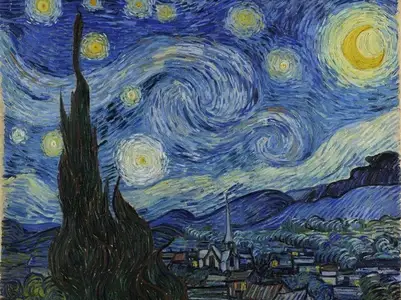Title of Artwork: “The Starry Night”
Original Title: ‘De sterrennacht’

Artwork by Vincent van Gogh
Year Created 1889
Summary of The Starry Night
The starry sky in Van Gogh’s paintings is a field of churning energy. The community is peaceful and orderly beneath the shower of stars. The flamelike cypress, a tree typically linked with cemeteries and sadness, bridges the gap between the ground and the heavens. For van Gogh, however, death was not foreboding.
“He remarked, “When I look up at the stars, I can’t help but fantasise. Why, I wonder, shouldn’t the glittering dots of the sky be as easily accessible as the dark dots on the map of France?” Getting to a star is a lot like taking a train to Tarascon or Rouen; you have to die first.”
The artist described his early morning view of the countryside to his brother Theo, writing, “This morning I observed the country from my window a long time before sunrise, with nothing but the morning star, which appeared quite enormous.” Some have speculated that the enormous white star to the left of the centre of The Starry Night is actually Venus, the morning star.
But the village is made up, and the church tower is reminiscent of van Gogh’s native Netherlands. The picture, like its daytime counterpart The Olive Trees, has its origins in the mind and the past.
Van Gogh’s art became a benchmark for all subsequent Expressionist painting after he abandoned the Impressionist ideology of faithfulness to nature in favour of restless sensation and strong colour, as shown in this emotionally charged painting.
All About The Starry Night
Vincent van Gogh, a Dutch post-impressionist, painted “The Starry Night” in oil on canvas. The scene was painted in June 1889 and portrays the scene outside the east window of his asylum room at Saint-Rémy-de-Provence shortly before daybreak.
The Starry Night is one of the most famous paintings in Western art history and is often considered to be among Van Gogh’s best. Since 1941, when it was donated by Lillie P. Bliss, it has been on display in New York City at the Museum of Modern Art.
After suffering a mental breakdown on December 23, 1888, during which he cut off his own left ear, Van Gogh checked himself into the Saint-Paul-de-Mausole lunatic asylum on May 8, 1889.
The former monastery that now serves as Saint-Paul-de-Mausole catered to the well-to-do, and was only about half full when Van Gogh arrived, so he was able to take up residence there, using both a bedroom on the second floor and a studio on the ground floor.
While in the asylum for a year, Van Gogh continued the prolific output of paintings he had begun in Arles. The Irises from May 1889, now in the J. Paul Getty Museum, and the blue self-portrait from September 1889, currently in the Musée d’Orsay, are two of his most well-known paintings from this time period.
Since he informed his brother Theo that he had completed a fresh study of the night sky on June 18, we can estimate that Van Gogh completed The Starry Night sometime in the middle of the month.
It would be a stretch to say that Van Gogh painted The Starry Night from memory, even though the artist worked on it during the day in his ground-floor studio. Evidence suggests that this is the view that would have been seen by Van Gogh from his bedroom window, which faced east.
He depicted this image in some form or another twenty-one times, most famously in The Starry Night. In a letter dated around May 23, 1889, he described the view outside his iron-barred window: “I can see an enclosed square of wheat… above which, in the morning, I watch the sun rise in all its grandeur.”
Van Gogh captured the scene at a variety of times of day and in a variety of weather situations, from sunrise to moonrise and from sunny to cloudy to windy to rainy.
Staff at the hospital forbade Van Gogh from painting in his room, but he was free to draw sketches there using ink or charcoal on paper. He would later use these sketches as a foundation for more finished works based on the originals.
The gentle undulations of the Alpilles Mountains are depicted as a diagonal line entering from the right in each of these paintings.
Fifteen of the twenty-one iterations show cypress trees beyond the far wall surrounding the wheat field. In six of these works, most notably. Wheat Field with Cypresses and The Starry Night, Van Gogh enlarged the view by a factor of 1.5 or 2.0, bringing the trees closer to the picture plane.
Mountainous Landscape Behind Saint-Rémy, was one of the earliest depictions of the area and is presently housed in Copenhagen. The Enclosed Wheatfield After a Storm is representative of the several drawings Van Gogh produced for the painting.
It’s not known if he painted it in his studio or outside. In his letter from June 9 detailing the experience, he reveals that he had been engaged in outdoor labour for the preceding few days.
On June 16, 1889, in a letter to his sister Wil, Van Gogh discussed the second of two landscapes he mentioned he was working on at the time. The first picture he completed outside the asylum, en plein air, was Green Field, which is now in Prague.
The New York wheat field of is based on one at Saint-Rémy-de-Provence. Vincent mentioned painting “a starry sky” in a letter to Theo two days later.
Information Citations:
En.wikipedia.org, https://en.wikipedia.org/.






















